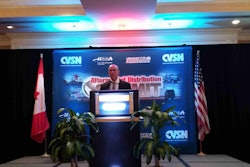Sam Geist says businesses today spend 80 percent of time on strategy and 20 percent of time execution. And he can’t figure out why.
In Geist’s eyes, the latter seems significantly more important than the former.
“Execution is not part of the strategy, it is the strategy,” he says. “If you want specific outcomes you need specific actions.”
During a presentation Monday at the Commercial Vehicle Solutions Network (CVSN) Aftermarket Distribution Summit in Vancouver, Geist warned aftermarket business leaders that getting too caught up on strategy—and overlooking execution—is a good way to develop business plans that ultimately never work.
“To make strategy work you have to drive execution,” says Geist. “We spend hours and hours on strategy but not enough on executing. We need to reverse it. Execution is the strategy.”
Geist says one reason businesses get caught up in strategy is it’s a lot more interesting. Strategy is thought-provoking. It’s forward thinking. It’s exciting.
Execution, conversely, is the hard work that comes with it.
“Strategy is for the few, execution is for the whole company,” he says.
But Geist says businesses that commit to execution never regret it. He references Starbucks, whose CEO Howard Schultz has been quoted as saying “Execution gives you the license to expand the brand.”
Geist says that’s an opportunity that should entice any business leader.
Geist also believes execution can help motivate and engage employees, further strengthening action plans while also dramatically limiting turnover and minimizing mistakes.
“Disengaged employees experience a 60 percent drop in quality and a 1,000 percent increase in errors,” Geist says.
Ultimately, Geist says execution gives your business value to your customers. He says a great customer service strategy doesn’t retain a single customer. It’s the boots on the ground—in the aftermarket’s case, the drivers and counter people in your operation—that are truly responsible for making a customer service strategy a success. If their responsibilities are clearly established and monitored, they’ll execute. If they don’t, Geist says customers notice.
“Every time an order is neglected, a customer is neglected,” he says, adding “a business without customers isn’t.”











